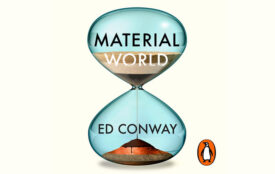Socrates didn’t invent solar architecture
Did you know that Socrates gave lectures on solar architecture? But no, he’s not the one who invented it – that honor goes back at least to the Chinese, according to the update of John Perlin’s classic from the 1970s entitled “A Golden Thread.” The new version, entitled “Let it shine,” was worth the three decades’ wait. A few years ago, I got a phone call from a man named John in California. He was looking for someone who could help him navigate a text in German on solar architecture – from the 1800s. By Craig Morris
Perlin went to similar means in a number of countries. As the author of “A golden thread: 2,500 years of solar architecture and technology,” (a book that has five stars at Amazon) he was constantly talking with people worldwide. When some Chinese acquaintances told him that, of course, ancient China had had solar architecture, he began researching (with the aid of Chinese friends to translate texts in ancient Chinese) and discovered a wide array of solar applications – from urban planning to handheld solar cookers going back to 3500 BC. The new book now takes readers back 6,000 years.
As someone who has been closely involved with the annual Passive House Conference in Germany for years, I thought I knew most things about the architecture and its history, so it was a shock to hear that the movement had started nearly 200 years ago. In his new book, Perlin shows the continuity in the German solar movement over the past two centuries. As he recently told me on the phone, “Germany’s solar leadership is 200 years old.”
The continuity is fascinating. A doctor named (of all things!) Faust was interested in public health. He helped make vaccinations popular in Germany, but he also argued that buildings need to have glazed southern façades in Germany to provide a healthier, warmer indoor climate – and he even had ideas about natural ventilation to provide fresh air. The knowledge from Faust’s book was translated into an active solar building program in the 1820s through the 1850s in Lower Bavaria, Hessen and Prussia.
Faust’s ideas were implemented in Bavaria, where the first solar schools were built. Faust’s Sonnenstadt plan was an ideal solar city, and the frontispiece to his book became a reality as the inspiration for the rebuilding of La Chaux-de-Faunds, Switzerland in the 1850s. In 2009, the United Nations chose the city as a World Heritage Site.
The trend eventually led to Bauhaus in the 1920s but came to an abrupt end under the Nazis in the 1930s. A few decades after World War II, German architects and urban planners picked up the solar baton again and have been running with it since.
Faust got his inspiration from living in a proto-Passive House built (still standing, see image below) in 1649 in Bückeburg, Germany to write the first solar book ever published – “All Buildings of Men Should Face the Midday Sun” (the book I translated). As I worked for Perlin, I realized I would have to read his book from the 1980s (but partly researched in the 1970s). The long list of examples he uncovered decades ago is still overwhelming today, and I read the book with my tablet in one hand so I could look up all of these unbelievable findings online. Sometimes, I was just looking for a school building in Arizona to see if Google Maps still showed its decades-old solar thermal roof array. Sometimes, I was looking to see what I could find about some old solar firm that had cornered the residential market in some US state in the 1930s or 1950s.
Often, I wasn’t able to find online what Perlin writes about. Amazingly, he knows how to find things the old-fashioned way – outside of the Internet. In the time I have been communicating with him, for instance, Dr. Faust’s Wikipedia entry in German has greatly improved, but it has not yet been translated into English. Likewise, although Perlin wrote about it decades ago, the Wikipedia entry for Socrates does not mention his lectures on solar architecture at all.
Much of what Perlin has to say about photovoltaics in the new book is new because so much has happened with PV since the early 1980s. But that’s okay, because Perlin is also the author of “From space to Earth: the story of solar electricity” (another book that has five stars at Amazon), so he is able to cover events in those decades quite well. (Did you know that, along with NASA and the US military, the oil sector in the US was one of the first big buyers of solar PV?) While we’re at it, he’s also the author of “A forest journey: the story of wood and of civilization,” which only has 4 1/2 stars – but did you know that the Fall of the Roman Empire was the result of an energy shortage… a lack of timber?
For that matter, did you know (as Perlin explains in the new “Let it shine”) that the Fall of the British Empire started when Gandhi showed his compatriots that they didn’t need to buy salt from the British? Indians had been making salt with solar energy for generations. And did you know that solar salt was a key factor in the American Civil War?
There is a lot in his new book to marvel at even if you recently read his old 2,500-year history of solar. The thing that probably impressed me the most was his coverage of the old Arthur D. Little study recommending that the US government promote solar power around 1980, when Ronald Reagan took office. Those of you who have been in the solar sector, especially in the US, for a long time have probably heard countless stories about all the terrible things the Reagan administration did to the fledgling solar sector when he came into office. The Arthur D. Little study is a big part of that story, perhaps the biggest. No, you can’t download it as a PDF online. The Reagan administration had every copy of it they could find destroyed.
At least one copy survived, perhaps only one. Recently, Perlin received it in the mail.
Want to know more? Check out the synopsis at National Geographic. There’s also a nice summary at Mother Earth News. Or the one on Perlin’s website. Or better yet: Read the book yourself
Source
Craig Morris 2013 | Petite Planète 2013 | Renewables International 2013








